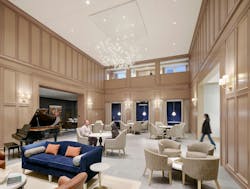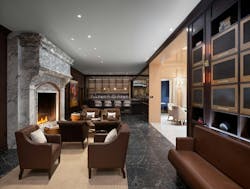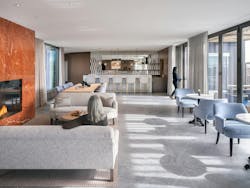Historic D.C. Hotel is Reimagined as a Luxury Senior Living Residence
Key Highlights
- The Fairfax Hotel, a historic landmark since 1927, now serves as a luxury senior living community with a blend of original Beaux-Arts features, contemporary tones, and modern materials.
- Structural adaptations were made to meet current load capacities and accessibility standards, transforming hotel rooms into spacious, private residences with clinical infrastructure.
- The project emphasizes outdoor access and natural light, especially for memory care residents, with features like terraces, outdoor spaces, and intuitive navigation elements.
Since 1927, Washington, D.C.’s Fairfax Hotel has been a magnet for prominent figures—from the Kennedy family and Margaret Thatcher to celebrities such as Frank Sinatra and Julie Andrews. Originally known as the Carelton Hotel and built to help soldiers transition to civilian life, the Beaux-Arts landmark near DuPont Circle later evolved into the epicenter of D.C.’s social and political scene, with its famous Jockey Club restaurant serving as the backdrop for countless power lunches and diplomatic encounters.
Today, the century-old building embarks on its next chapter as Inspīr Embassy Row DC, a luxury senior living community that preserves the grandeur of its storied past while creating spaces designed expressly for mature residents and memory care.
A Storied Past Reimagined
After eventually becoming the Fairfax Hotel, the building changed ownership and went through several renovations before Maplewood Senior Living and Inspīr took the reins to transform the historic property into a luxury assisted living and memory care facility.
“To find an historic hotel like the Fairfax that has been enjoyed by so many of the customers that can now live in and enjoy our new Inspīr brand was just an opportunity that we couldn’t pass up,” stated Inspīr Senior Living chief operating officer Shane Herflet.
Preserving the grandeur of the detailed and ornate Beaux-Arts architecture-styled façade, Beyer Blinder Belle Architects and Planners was tasked with redesigning the spaces to reflect the building’s historic past with classic yet modern décor and furnishings suitable for a mature clientele, including those who require memory care.
“Arched doorways, ceiling patterns, and warm material palettes were reimagined in contemporary tones to offer visual continuity.” said Tom Gaston, co-CEO of Maplewood Senior Living and Inspīr Senior Living. “The new interiors are informed by details from the building’s past—like millwork, ornamental metals, and ceiling coffers—to help create familiarity and comfort. Colors were inspired by the building’s existing finishes—rich earth tones and soft neutrals that evoke calm and sophistication.”
A Grand Tour
The experience begins in the lobby where the restored millwork, a vintage postal chute, and gold-framed arched glass openings blend with contemporary finishes, furnishings, and a concierge-style reception desk.
Moving through the common areas, patrons encounter high-end materials like brushed brass, natural stone, white oak, and plush textiles offering a tactile sense of luxury while remaining functional and comfortable for older adults.
Inspīr Embassy Row DC also features a large art collection—with more than 70 original commissioned works—curated in partnership with Morton Contemporary Gallery.
A stately library is anchored by an original marble fireplace with leather seating and dark wood wall surfaces. And a two-story gathering room is decorated with light wood cladding, a reimagined marble fireplace, a grand piano, and small curtained-off rooms.
“We worked closely with Inspīr to choose finishes that bridge historic character and contemporary luxury—like classic wainscoting paired with sleek lighting, or coffered ceilings framing modern chandeliers,” explained Jill S. Cavanaugh AIA, AICP, partner, Beyer Blinder Belle Architects and Planners.
Modern Amenities
In addition to recreating the common areas, updating the residential units, and adding lounges on each floor, the building team carved out new spaces that included a wellness suite and rooftop terrace.
Thinking creatively about how existing space could be repurposed, the team adapted part of the parking garage into double-height wellness amenities. Residents can now enjoy an indoor saltwater swimming pool, steam room, sauna, salt room, and fitness center.
The rooftop terrace provides an essential outdoor sanctuary for patrons, offering close to 360-degree views that include the National Cathedral, Washington Monument, and U.S. Capitol.
“Programmatically, access to daylight and outdoor space was an essential component of the project, particularly for memory care residents,” Cavanaugh continued. “We were able to create new opportunities for terraces and outdoor space by extending areas of the building and designing a new rooftop lounge to take advantage of the extraordinary views.”
Adapting for Compliance
Still, the project was not without its challenges. One particular concern the team encountered was adapting the structure to meet current live load capacities. This involved inserting new structural components and creating penetrations for vertical infrastructure. However, the original 1920s portion of the building utilized a terracotta slab system with structural clay tile supported by concrete ribs.
“All penetrations for new building systems had to be located within a single terracotta panel to avoid cutting the concrete, which required significant additional coordination to locate the penetrations so they worked functionally without compromising ADA clearances,” Cavanaugh said.
The design team also had to convert the hotel rooms, which were originally designed for short stays, into senior living residences, which demand long-term comfort, safety, and accessibility features.
“We had to rethink layouts to create spacious, private residences with en-suite bathrooms, while also integrating full clinical infrastructure,” Gaston explained.
Design-wise, the team also had to ensure that the custom, bespoke residences with their contemporary systems and décor were compatible with the historic elements such as the rhythm of the exterior windows.
Key modifications to the common areas also involved meeting current code and accessibility standards. Added memory care features like intentional sightlines, resting nodes, and distinctive design elements assist with intuitive navigation and foster a sense of place.
Seamlessly blending historic architectural details with modern luxury and clinical care, Inspīr Embassy Row DC has transformed a hotel into a home.
About the Author
Barbara Horwitz-Bennett
Contributing Editor
Barbara Horwitz-Bennett has been covering the AEC industry for the past 25 years. She writes for a number of industry magazines and works with AEC firms and product manufacturers on content writing projects.




